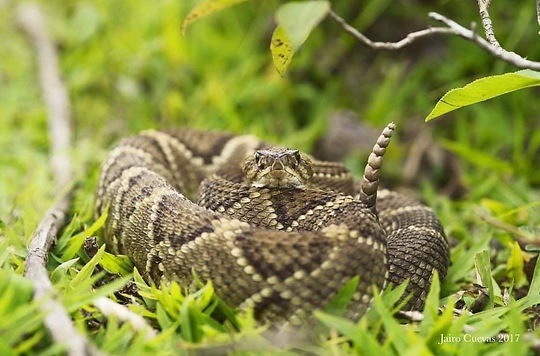
Photo credit:
Jairo Viridis
Common name
South American Rattlesnake
Scientific name
Crotalus durissus terrificus
Conservation Status
Least Concern
Federal and State Protections
Range Map
Countries of Occurrence
Brazil, Uruguay, Argentina, Paraguay, Bolivia, Extreme Eastern Peru
Adult size
76cm (29.9in) - 183cm (72in)
States or Providence
Maranhão (BZ), Piauí (BZ), Tocantins (BZ), Ceará (BZ), Rio Grand do Norte (BZ), Paraíba (BZ), Pernambuco (BZ), Alagoas (BZ), Sergipe (BZ), Bahia (BZ), Minas Gerais (BZ), Goiás (BZ), Espírito Santo (BZ), São Paulo (BZ), Paraná (BZ), Santa Catarina (BZ), Rio Grande do Sul (BZ), Mato Grosso (BZ), Mato Grosso do Sul (BZ), Rondônia (BZ); isolated populations in Amazonas (BZ) and Pará (BZ)
Salta (AR), Formosa (AR), Chaco (AR), Corrientes (AR), Misiones (AR), Entre Ríos (AR), Sante Fe (AR), Córdoba (AR), San Luis (AR), La Rioja (AR), Catamarca (AR), Tucumán (AR), Santiago del Estero (AR), Possibly eastern Mendoza (AR)
Concepción (PY), San Pedro (PY), Cordillera (PY), Guairá (PY), Caaguazú (PY), Caazapá (PY), Itapúa (PY), Misiones (PY), Paraguarí (PY), Alto Paraná (PY), Departamento Central (PY), Ñeembucú (PY), Amambay (PY), Canindeyú (PY), Departamento de Presidente Hayes (PY), Alto Paraguay (PY), Boquerón(PY)
Argitas (UY), Salto (UY), Rivera (UY), Tacuarembó (UY), Cerro Largo (UY), Treinta y Tres (UY), Rocha (UY) Lavalleja (UY), Maldonado (UY)
Santa Cruz (BO), Beni (BO), La Paz (BO), Tarija (BO), Cochabamba (BO), Chuquisaca (BO)
Puno (PE), Madre de Dios (PE)
Counties
Species Description
The South American rattlesnake, known as the Cascavel in Brazil, is a large-bodied and highly venomous snake found in the Cerrado ecoregion of southern Brazil, Uraguay, Paraguay and northern Argentina. Cascavels make their home in grassland and savanna habitats, though some may be found in dry forests and open clearings of jungles. There is research which suggests this subspecies may experience a southward range expansion due to climate change; however, this is not certain as encroaching human development reduces both current and potential habitat.
This species feeds primarily on rodents, which are abundant in the dry savanna and scrub habitats comprising its range; however, marsupial prey are also taken and a small number of ameiva lizards have been recorded from the stomachs of females.
Mating season occurs in the Southern Hemisphere autumn months (April & May). Males are known to engage in ritualistic combat to compete for females. Females store sperm from suitors over winter, and then begin a gestation period of 4 - 5 months beginning in the spring (September & October). Newborns are usually 25-34cm at birth, and are born in litters of 12-33. Females from southeastern Brazil tend to mature at smaller sizes and give birth to smaller litters than those from northeastern Brazil.
Unlike most other members of the genus Crotalus, there is no sexual dimorphism in regard to size of males and females.
Fun Fact: Their venom has been shown to inhibit the life cycle of the Hepatitis C virus, one of the main causes of liver disease worldwide. This can lead to a treatment down the road for this virus and others!




.png)